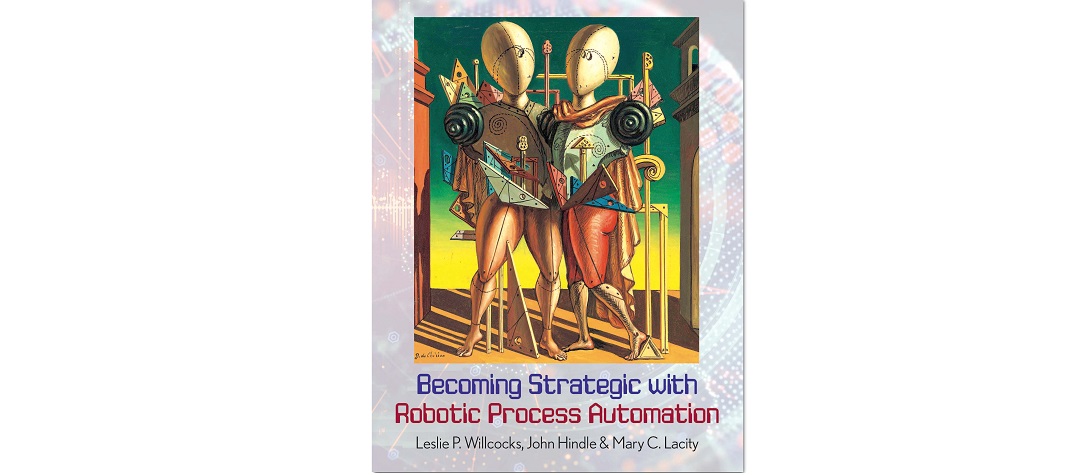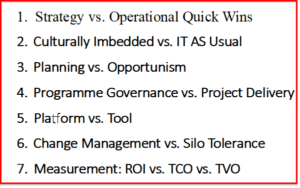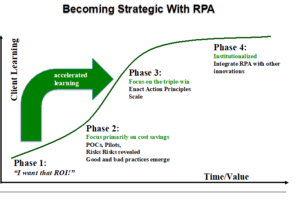Strategy is a much abused word in management, having a longer pedigree of hype than say… artificial intelligence. Strategy seeks to answer three fundamental questions for the organization: where are we now? Where do we want to be/must we be? And how do we get there? Enter robotic process automation (RPA). To become strategic, RPA needs to be significant in its impact on process improvement/change and business value, but also part of a larger automation and digital transformation plan tied to strategic business goals. Strategic behaviour focuses on the relatively few technologies and applications that produce disproportionate business value, by critically underpinning strategic direction and gaining competitive advantage.
In researching our new book ‘Becoming Strategic With Robotic Process Automation’, we identified seven RPA strategic performer attributes (Figure 1). Six are well supported by the evidence. The seventh – focusing on total value of ownership (TVO) – is the subject of on-going research.
Figure 1: Client Practices On Strategy: Seven Key Attributes
Strategy vs. Operational Quick Wins
Leading companies observe a fundamental rule: business strategy drives RPA investments. RPA historically has been seen as a tactical, quick-win tool to achieve business benefits and bypass the IT work queue. Moving from a tactical cost focus to multi-faceted strategic impacts follows a typical pattern (Figure 2). Many RPA users move, sometimes painfully, through Phases 1 and 2, to get to Phase 3. Pioneers like Telefonica O2, RWE npower, Innogy SE business solutions, Barclays Bank, and Shop Direct matured their own strategic understanding over time and now operate with Phase 3/4 mind-sets.
Figure 2: Becoming Strategic With RPA
Click image to enlarge
Source: Willcocks, Hindle and Lacity (2019)
Client experiences and our knowledge built up over the last four years now allows companies like Bank of New York Mellon, beginning their journey in early 2016, to accelerate their learning and kick-start at Phase 3. Even by mid-2017 they had over 200 robots in production and had automated more than 100 processes.
We found Phase 3 clients going for a triple win of shareholder, customer and employee value. The secret here was the higher aspiration. Clients aimed for and were getting multiple business benefits but were producing also unexpected returns, for example discovering much better regulatory compliance, products quicker to market, enhanced customer journeys and increased employee skills and recognition. Mars found that structuring an Enterprise Digital Transformation strategy, with a component of that strategy being automation, enabled much greater benefits to accrue to the organization. In 2016 Ericsson developed a thorough digital transformation strategy aiming to become a customer-centric, data-driven digital business. Following classic management practice, they gave themselves actionable, specific stretch goals. These were to automate all repetitive tasks by 2021, produce $US56 million cost savings by end of 2018, and to achieve automation maturity across all 20 main business units within the next few years.
Culturally Imbedded vs. ‘IT As Usual’
To be transformative, automation must have cultural adoption by the C-suite, manifested in senior executive behaviour. They sponsor and project champion service automation. They see RPA as a strategic business project and provide the requisite financial and human resources. They communicate clearly on automation, and ensure that governance and project structure are in place. They protect developments when they run into difficulties. A prime example in our case studies has been Xchanging (now DXC technologies) where, in 2014, CEO Ken Lever promoted ‘putting technology at our core’ as an annual report message. By June 2015, Xchanging had automated 14 core processes with a range of significant business benefits. In practice, clients point out, it is difficult to scale and gain the really significant strategic benefits from RPA without top-down management and senior executive support.
Planning vs. Opportunism
Jon Theuerkauf, in June 2016 managing director and group head of performance excellence at BNY Mellon, stated as one of his principles: ‘begin with the end in mind’. More precisely, BNY Mellon planned for the mid-term and long-term end-points, and recognized that the ‘end-point’ would be continually redefined. We have found this typical of clients with a strategic mind-set.
During 2017, most leading users characterised the end-point as establishing an RPA Center of Excellence (CofE), then an automation CofE focused on applying several technologies such as RPA, cognitive, and analytics. By 2018 we found 67% of leading clients treating RPA as part of a larger automation or larger digital business strategy. Reporting in March 2019, HFS research found more representatively only 11% of all companies leveraging integrated solutions that combine the power of automation, analytics and AI. Leading companies like American Express, IBM, BNY Mellon, ING, Nordea, and Siemens planned to start slow, then scale fast. They looked for a rich business value proposition. Such clients aim for high return on investment (30-200%) an ‘triple wins’, in terms of shareholder, customer and employee value. Clients were increasingly enhancing RPA usage by adopting complementary cognitive technologies, for example at Zurich Insurance in the claim validation process, and at KPMG in audit, business generation, and risk assurance validation processes.
Program Governance vs. Project Delivery
A common mistake has been to treat RPA as just another piece of software. This leads on to limited governance arrangements, and tends to repeat the mistakes when ERP systems were first introduced, Our case research shows that leading RPA users across sectors take a different route. Like Siemens, innogy SE and BNY Mellon, for example, they see RPA as potentially more transformational. The constitution (‘rules of the game’) for automation is formulated Day One, and covers decision-making and responsibilities for technology, process, data, business and resources. In fact, with some RPA products, clients get built into the software a lot of technical governance covering security, compliance, change management, ease of integration with infrastructure, and fit with enterprise applications. Some vendors also detail the vital role of the IT department in governance and making RPA function optimally.
Platform vs. Tool
The requirement for governance comes from seeing RPA as a platform, rather than just another automation ‘tool’. The ‘tool’ view sees RPA being sidelined and overtaken by more advanced cognitive automation tools for image recognition, natural language processing, machine learning, and algorithmic reasoning, driven by huge advances in computing power and storage. Conversely, amongst leaders, RPA is utilized as part of a continuum of complementary automation and digital technologies supporting enterprise digital transformation. We found leading clients also stressing the advantages of enterprise platform capabilities, citing, in particular, enterprise wide scalability, low coding requirement, strong security, and design for enterprise integration. Bank of Ireland is a good example. By 2018 the bank was using a robotic digital workforce numbering in the hundreds across a wide range of processes. In the next year, they were able operationalize a new application of the RPA platform to accomplish a previously impossible task – a massive customer data refresh and cleansing processes equivalent of up to the work of 850 FTEs – because they had invested in a strategic enterprise level RPA deployment.
By early 2019, the technology providers had already become more sophisticated about moving from selling automation tools to providing integrated automation platforms. Throughout 2019 this remained very much work-in-progress but it proceeded at a fast pace amongst RPA players themselves, systems integrators, Meanwhile, systems integrators, analytics and cognitive/AI firms and enterprise software producers. This complicates choice immensely for client firms and providers alike. Understanding and participating in how this plays out will demand a much more strategic approach to RPA and automation
Change Management vs. Silo Tolerance
Used opportunistically, RPA tools can gain quick wins, but too often they have been deployed as a sticking plaster on pain points in the organization. This has the advantage of not having to deal with change management issues, but the serious disadvantage of turning down the transformation potential of automation. Most organizations are surprisingly heavily siloed. When we look at the slow pace of RPA and cognitive automation in many organizations, we find it correlates with the existence of multiple siloes, including structure, functions, process, data, technology, skills, culture, and management mind-sets. From mid-2018 into 2019, as RPA adopters increasingly scaled to reap more benefits, they encountered major challenges on change management.
Amongst leading clients, senior executives tend to recognise early the transformation potential of RPA, and explicitly manage the change implications for data, technology, people, processes, and structures. Siemens provides us with one example of bringing these and our other points together. For its shared services, Siemens established a global RPA CoE in mid-2017, to define a global approach. It looked to integrate RPA with the business process/management/operations platform and enterprise platform globally. Critical success factors included integrating RPA into a broader automation strategy, alignment with process governance, C-level support with risk capital, and process optimization being combined with RPA. Other critical success factors included partnering with IT and external partners; developing expertise in automation and process optimization; clear governance and operating model, a centralized framework for IT architecture and infrastructure, and stakeholder communications and change management.
Leading clients have found it particularly important to get early stakeholder buy-in – from business operations managers, IT, employees and senior executives. This, we find, involves fully resourcing change management capability, messaging the purpose and value of RPA to staff, and ensuring strategic alignment, new competencies, and changes are institutionalised and imbedded in work practices. One key issue is communicating clearly, honestly and early what is likely to happen to jobs as this is a real issue for employees.
Measurement: ROI v. TCO v. TVO
Making new technology investments has always been problematic. Getting the right measurement system is a major key to driving business value. In the past organizations have tended not to fully investigate risk and potential costs, understated knock-on cost of operations and maintenance, and not properly accounted for rising human and organizational costs. Typically, we found that organizations using traditional return on investment (ROI) cost/benefit analysis understated real costs, which frequently exceeded technical costs by 300-400%.Our evidence is that many RPA users are committing the same mistakes.
One remedy has been to refocus on Total Cost of Ownership (TCO), defined as the total technical, project, human and organizational acquisition and operating costs as well costs related to replacement or upgrades at the end of the life cycle. This is fine so far as it goes, but the real limitation so far in RPA assessment has been in establishing benefits. We, with Knowledge Capital Partners, have invented a new measure called Total Value of Ownership (TVO) to ensure the business cases for service automation is driven by (1) total costs, (2) multiple expected business benefits and (3) the strategic returns from future business and technical options made possible by automation. The benefits side consists of three ‘E’s – efficiency, effectiveness and enablement. We document the TVO measure in our new book, and several articles.
In summary, the seven practices when combined add up to becoming strategic with RPA – the key, most influential single management practice of leading clients with superior business outcomes.
Leslie Willcocks, John Hindle and Mary Lacity are co-authors of Becoming Strategic With Robotic Process Automation, published by SB Publishing in October 2019, and available from www.sbpublishing.org
Leslie Willcocks is Professor in the Management department, London School of Economics
John Hindle is Managing Partner in Knowledge Capital Partners
Mary Lacity is Professor, Sam M. Walton College of Business, University of Arkansas














